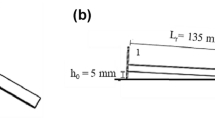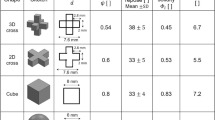Abstract
In mineral processing, ore grinding is an energy-intensive process. Tumbling mills used in grinding processes can be accounted for as rotating drums with liners. As part of an effort to evaluate ways of reducing energy consumption in such systems, therefore, particulate flows in rotating drums are studied in this work. More specifically, using a new DEM tool, which is one of the modules of a larger in-house computational package called CFLOWSS, particulate flows in rotating drums are qualitatively and quantitatively analyzed. The results from such analyses are compared with experimental ones and other numerical results obtained using a commercial DEM software. In qualitative terms, the CFLOWSS results show a relatively good agreement with experimental photographs previously taken in a laboratory. In quantitative terms, in turn, the CFLOWSS predictions show a strong correspondence with those ones made by the commercial software. For instance, the relative discrepancies of the boxplots’ medians associated with the number of contacts, power, and forces predicted by both (in-house and commercial) tools present values smaller than 8%. At a 60 RPM drum rotation velocity, indeed, the number of contacts related discrepancies reach values as low as 0.8%. Some of the contributions of this work involve (i) the development of a new DEM tool capable of realistically describing particulate flows in rotating drums, and (ii) the use of statistical treatments to quantitatively analyze DEM results. This last aspect is important because this sort of assessments provides an improved way to analyze the behavior of particulate flows.








Similar content being viewed by others
References
Fuerstenau MC, Han KN (2003) Principles of mineral processing, littleton. SME, Colorado
Napier-Munn T (2015) Is progress in energy-efficient comminution doomed? Min Eng 73:1–6
Engeco (2021) Mining energy consumption 2021
Musa F, Morrison R (2009) A more sustainable approach to assessing comminution efficiency. Min Eng 22:593–601
Kloss C, Goniva C, Hager A, Amberger S, Pirker S (2012) Models, algorithms and validation for opensource DEM and CFD-DEM. Prog Comput Fluid Dyn 12(2/3):140–152
Brennen CE (2014) Fundamentals of multiphase flow. Cambridge University Press
Chou H-T, Lee C-F (2009) Cross-sectional and axial flow characteristics of dry granular material in rotating drums. Granul Matter 11(1):13–32
Rao KK, Nott PR (2008) An introduction to granular flow. Cambridge University Press, Cambridge
Ding Y, Forster R, Seville J, Parker D (2002) Granular motion in rotating drums: bed turnover time and slumping–rolling transition. Powder Technol 124:18–27
Mellmann J (2001) The transverse motion of solids in rotating cylinders—forms of motion and transition behavior. Powder Technol 118:251–270
Beke B (1981) Tumbling mill mechanics. The Process of Fine Grinding, pp 74–83
Fleischmann J, Serban R, Negrut D, Jayakumar P (2016) On the importance of displacement history in soft-body contact models. J Comput Nonlinear Dyn 11(4):044502
Pazouki A, Kwarta M, Williams K, Likos W, Serban R, Jayakumar P, Negrut D (2017) Compliant contact versus rigid contact: a comparison in the context of granular dynamics. Phys Rev E 96(4):042905
Cundall P, Strack O (1979) A discrete numerical model for granular assemblies. Géotechnique 29:47–65
Dubois F, Acary V, Jean M (2018) The contact dynamics method: a nonsmooth story. Comptes Rendus Mécanique 346(2):247–262
Moreau JJ, Panagiotopoulos PD (2014) Nonsmooth mechanics and applications. Springer, Berlin
Moreau JJ, Jean M (1996) Numerical treatment of contact and friction: the contact dynamics method. Eng Syst Design Anal Conf 4:201–208
EDEM (2014) EDEM Theory Reference Guide, Edinburgh: DEM Solutions
ESSS (2023) https://rocky.esss.co/software/?tab=overview, ESSS, 2023. [En línea]. Available: https://rocky.esss.co
Angeles L, Celis C (2019) Assessment of neighbor particles searching methods for discrete element method (DEM) based simulations. In: de VI international conference on particle-based methods: fundamentals and applications, Barcelona
Peralta S, Córdova J, Celis C, Maza D (2020) Numerical modelling of mineral-slurry like flows in a 3D lid-driven cavity using a finite element method based tool. In: ASME international mechanical engineering congress and exposition, vol 84584, p V010T10A023
Peralta S, Córdova J, Celis C, Maza D (2022) Parallel domain decomposition of a FEM based tool for mineral-slurry like flows numerical modeling. International Journal of Computational Fluid Dynamics (Under review)
Peralta S, Cordova J, Celis C, Maza D (2020) Development of an object-oriented programming tool based on FEM for numerical simulation of mineral-slurry transport. In: International conference on computational science, pp 163–177
Altair EDEM, «Altair,» [En línea]. Available: https://www.altair.com/edem/
Pöschel T, Schwager T (2005) Computational granular dynamics. Springer, Berlin
Kuwabara G, Kono K (1987) Restitution coefficient in a collision between two spheres. Jpn J Appl Phys 26(8R):1230–1233
Tsuji Y, Tanaka T, Ishida T (1990) Lagrangian numerical simulation of plug flow of cohesionless particles in a horizontal pipe. Powder Technol 71(3):239–250
Zheng Q, Zhu H, Yu A (2012) Finite element analysis of the contact forces between a viscoelastic sphere and rigid plane. Powder Technol 226:130–142
Di Renzo A, Di Maio FP (2004) Comparison of contact-force models for the simulation of collisions in DEM-based granular flow codes. Chem Eng Sci 59(3):525–541
Langston P, Tüzün U, Heyes D (1994) Continuous potential discrete particle simulations of stress and velocity fields in hopper: transition from fluid to granular flow. Chem Eng Sci 49(8):1259–1275
Langston P, Tüzün U, Heyes D (1995) Discrete element simulation of granular flow in 2D and 3D hoppers: dependence of discharge rate and wall stress on particle interactions. Chem Eng Sci 50(6):967–987
Norouzi HR, Zarghami R, Sotudeh-Gharebagh R, Mostoufi N (2016) Coupled CFD-DEM modeling: formulation, implementation and application to multiphase flows. Wiley
Luding S (2008) Introduction to discrete element methods: basic of contact force models and how to perform the micro-macro transition to continuum theory. Eur J Environ Civ Eng 12(7–8):785–826
Maw N, Barber JR, Fawcett JN (1973) The oblique impact of elastic spheres. Wear 38(1):101–114
Violeau D (2012) Fluid mechanics and the SPH method: theory and applications. Oxford University Press
Cleary PW (2004) Large scale industrial DEM modelling. Eng Comput 21:169–204
Ayachit U (2015) The paraview guide: a parallel visualization application. Kitware Inc.
Xu Y, Xu C, Zhou Z, Du J, Hu D (2010) 2D DEM simulation of particle mixing in rotating drum: a parametric study. Particuology 8(2):141–149
EDEM (2014) EDEM User Guide, Edinburgh: DEM Solutions
Li Y, Xu Y, Thornton C (2005) A comparison of discrete element simulations and experiments for ‘sandpiles’ composed of spherical particles. Powder Technol 160(3):219–228
Lorenz A, Tuozzolo C, Louge MY (1997) Measurements of impact properties of small, nearly spherical particles. Exp Mech 37(3):292–298
Acknowledgements
This work has been funded by CONCYTEC-FONDECYT (PROCIENCIA) (Peru) and the World Bank with contract No. 155-2018-FONDECYT-BM-IADT-AV, contract No. 015-2021-FONDECYT (ECOS NORD-PERU) and contract No. 10-2018-FONDECYT/BM-PROGRAMAS DE DOCTORADOS EN AREAS EXTRATÉGICAS Y GENERALES. This work has been also supported by the Engineering Doctoral program at “Pontificia Universidad Católica del Perú” (PUCP).
Author information
Authors and Affiliations
Corresponding author
Ethics declarations
Conflict of interest
On behalf of all authors, the corresponding author states that there is no conflict of interest.
Additional information
Publisher's Note
Springer Nature remains neutral with regard to jurisdictional claims in published maps and institutional affiliations.
Rights and permissions
Springer Nature or its licensor (e.g. a society or other partner) holds exclusive rights to this article under a publishing agreement with the author(s) or other rightsholder(s); author self-archiving of the accepted manuscript version of this article is solely governed by the terms of such publishing agreement and applicable law.
About this article
Cite this article
Angeles, L., Velez, K. & Celis, C. Qualitative and quantitative analyses of particulate flows in rotating drums using a DEM-based approach. Comp. Part. Mech. (2024). https://doi.org/10.1007/s40571-024-00753-8
Received:
Revised:
Accepted:
Published:
DOI: https://doi.org/10.1007/s40571-024-00753-8




